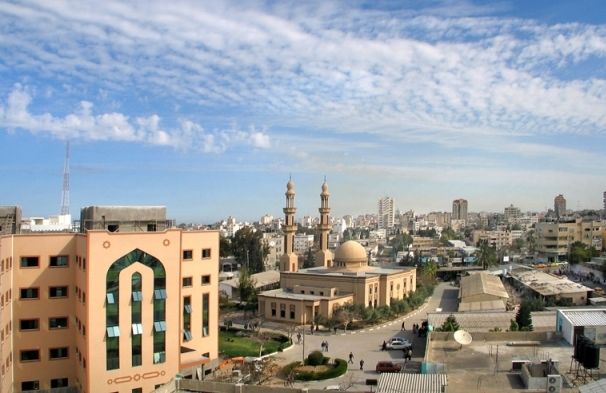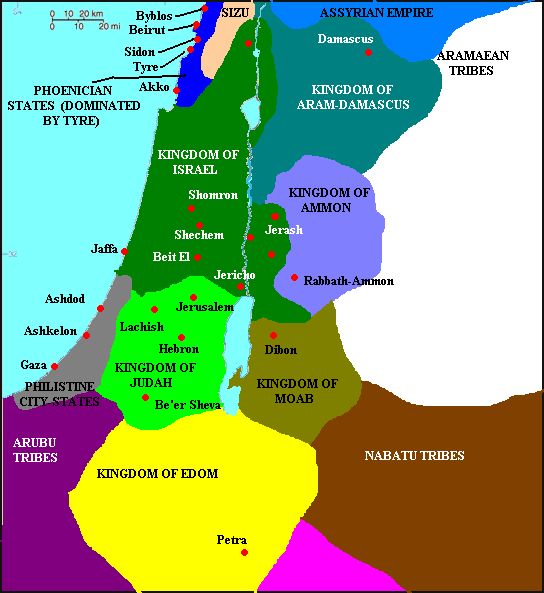
The mosque at the Islamic University of Gaza in Gaza City, as seen in 2009.
An ancient crossroads for trade routes through Middle East, the area has seen repeated conquest and occupation
Judging by the tone of many headlines, before and after the last Palestinian election 10 years ago, one might assume the people of Gaza have been marauding terrorists for time immemorial.
Israeli Defense Minister Avigdor Lieberman’s comments this week to Palestinian daily Al-Quds were no exception, as he emphasized “extremely radical elements” in the impoverished territory of 2 million people.
But there’s a long history of cultural mixing, along with invasion and settlement by countless empires, many of which are antecedents to contemporary nation-states. There was also an ancient polity of Philistia, with no fixed border — albeit with considerably more land than the modern Gaza Strip — which existed more or less in the same place.
Located on the Mediterranean coast along a key trading route, the market hub of Gaza — the city that gives its name to the narrow coastal region — was always an important stopover point in the southern Levant.
Many hoped the Palestinian Authority's failed yearlong unity government would bring yet a new power shift, but the effort wasn’t the first or the last attempt to rule over Gaza.
“Gaza was occupied, destroyed and rebuilt many times, due to the fact that it borders Asia and Africa,” said archaeologist Moain Sadeq, a Qatar University professor who co-founded the Palestinian Department of Antiquities in Gaza. “Every power, every army, north and south, has tried to occupy it.”
The Philistine ‘pentapolis’
Egyptians used the city of Gaza as their administrative capital in Canaan, and pharaohs called the shots for three centuries, until about the 12th century BC.
Then the Philistines ruled throughout a five-city pentapolis that included Gaza, Ashdod and Ashkelon, and went as far north as Jaffa, part of modern Tel Aviv. It also encompassed Gath (biblical Goliath’s hometown) and Akron, which both lent their names to contemporary kibbutz towns.
According to some historians, the Philistines were technologically more advanced than the Hebrews, even though their name came to be a pejorative term for “uncultured.” Considered to derive from the “Sea Peoples,” their origins are purported lie to the north around the Aegean Sea or Southeast Turkey. They initially spoke their own Philistine language, which many scholars believe was non-Semitic.

Map of the Levant from 830 BC showing Philistia, which in some accounts is larger than indicated.
In the biblical era, Tel al-Muntar was the place where Samson was said to break the city gates, before he committed murder-suicide. In the Greek translation of the Septuagint, the Philistines are known as “Allophyli,” which translates to “other peoples.” This may reflect a sort of historical consciousness that continues to influence public imagination today, millennia after Philistines menaced Kings David and Saul in Jerusalem.
“Just as the Philistines and Israelites fought each other, they also lived side by side -- and interacted peacefully as well,” said Professor Aren Maeir of Bar-Ilan University. “One can see perhaps a similar picture with the modern Palestinians and Israelis.”
However, Maeir added, “Most Palestinians today follow a narrative which does not see the Philistines as their cultural forefathers, but rather claim that the pre-Israelite/Philistine peoples of Canaan (Canaanites, Jebusites, etc.) are their forefathers.”
Levantine conquerors
The seaside terrain was consecutively taken by the Israelites, Assyrians, Babylonians, Persians and Macedonians. The cycle of conquest is “more or less the story of the ancient world in general and the southern Levant specifically. And Gaza is like just about any other part of this region,” said Maeir.
Gaza’s Marneion was the center for worship of Marnas, the Hellenistic Greek incarnation of the Semitic deity Dagon, who represented fertility, grain, and fish. Later on, the Romans renamed their province of Judea — which for a time included Gaza — as Palestina, the Latinized version of Philistia.
Gazans mounted stiff resistance to adopting Christianity, so during the Byzantine era the regional diocese was headquartered in the neighboring city of Maiuma. The brutal conflict between die-hard pagans and followers of Jesus is documented hagiographically by Saint Porphyry, the bishop of Gaza. Eventually that port area would become a coastal belt of posh hotels called Rimal.
As the first city in Palestine taken by the Arabs under the second Rashidun caliph Umar ibn Al-Khattab in 635 AD, Gaza quickly became a center of Islamic learning. The founder of the Shafi school of Islam was born there. The city was later conquered by the Crusaders, who built a Knights Templar castle. Shia Islam, spread under the Fatimids, dominated until the 12th century, when Saladin, a Sunni, conquered it for the Ayyubids.
The Mongols never got closer to Africa than in Gaza, which they ravaged in 1260. An earthquake severely damaged the city in 1294, only to see the bubonic plague kill the majority of its inhabitants barely fifty years later.
In the Shuja’iyya suburb, the census of 1525 included many Kurdish and Turkmen families. Jews resided for centuries in the Al-Zaytoun quarter of the Old City, and a Samaritan bathhouse is said to date back to the Mamluk era.
Restored by the Ottomans, Gaza’s Great Mosque in the Daraj Quarter of the Old City was reportedly built on the site of a Philistine temple. The centuries-old Omari mosque in nearby Jabalia, just one of dozens of Muslim holy sites destroyed in the 2014 war, fell prey to the continuous cycle of destruction that has plagued Gaza's history.
Napoleon’s army crossed through Rafah in 1799. Decades later, an American visitor noted in 1838 that most of the city’s patrimony had disappeared due to constant war.
Modern rule by the sword
As Gaza saw the cross-migration of many peoples, including Bedouins traveling via caravan across non-existent borders, a series of outside military powers ruled Gaza — from the Turks to the British, Egyptians, and Israelis.
Under the British, the Gaza district extended well up the coast. The UN partition plan of 1947 included about four times more land adjacent to Gaza than the current territory, formed during the 1948 war, and still more than is promised in a proposed land swap as part of a future peace deal based on the 1967 borders. Many of Gaza’s inhabitants are descendants of refugees from mere dozens of miles away, who are now squeezed into the extraordinarily dense Gaza Strip.
The First Intifada was accompanied by the symbolic Palestinian Declaration of Independence in 1988. Israel granted the territory self-rule in 1994 as part of the Oslo Accords with the Palestinian Liberation Organization, under which the populated urban areas would be administered by Yasser Arafat’s Palestinian National Authority. Jewish settlements were maintained until the IDF pulled out in 2005, at the tail end of a disastrous Second Intifada. Gaza, along with the West Bank, is one of the two territories of the State of Palestine for which Mahmoud Abbas gained observer status at the UN in 2012.
While the most famous Gazans in recent years have arguably been military and political leaders from the Palestinian Islamist group Hamas, which won a democratic election before carrying out a violent counter-coup in 2007, another notable local is Arab Idol winner Mohammed Assaf.
Gaza’s legacy of steadfastness is apparent, as its museum of archaeology still struggles to reclaim antiquities hauled off to the Israel Museum decades ago.
Perhaps ironically, Gaza's current arch-nemesis, Israel, also has two museums dedicated specifically to the Philistines.
Drawing a direct line from today's Palestinians back to this ancient people, who largely disappeared more than two millennia ago, is controversial. Regardless, the name stuck around. And despite a series of three brutal wars punctuating iron-fisted rule by Hamas — along with lingering vestiges of occupation, multiple humanitarian crises, and a military siege — so has Gaza.
“Gazans believe they are part of the Palestinian state, whenever and wherever it will be established,” Professor Sadeq said. “They don’t want to be part of Egypt or any other country. That is the present and future of the people. They are Palestinians and will stay Palestinian.”
